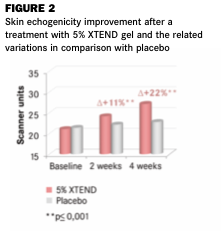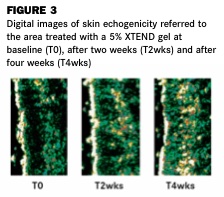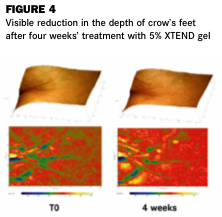Skin ageing is caused by a number of different factors that trigger biochemical and structural changes, finally leading to loss of skin firmness and elasticity. The primary player in these degenerative processes is oxidative stress. It is caused by a huge increase in reactive oxygen species (ROS) which exceeds the capacity of physiological antioxidant systems. Supplementing topical antioxidants can promote a beneficial effect on skin ageing, by counteracting ROS imbalance and preventing wrinkle formation, as well as loss of tightness. The novel natural ingredient XTEND by Sinerga results from the combination of two natural extracts and a naturally-derived skin permeation enhancer. Following in vitro and in vivo tests, XTEND was found to be able to perform a cytoprotective and extracellular matrix recovery activity, which has led to both prevention of cutaneous damage by oxidative stress and improvement of skin firmness and smoothness.
Mechanisms of ageing
Skin, as the outermost body organ, is particularly affected by all environmental factors during its entire lifetime. The combination of endogenous and exogenous factors leads to cumulative structural and physiological alterations in skin layers, a phenomenon commonly referred to as skin ageing[1,2].
One of the hallmarks of aged skin is the decrease in skin firmness and the increase in roughness, caused by fundamental changes that occur within the dermal extracellular matrix leading to a loss of architectural uniformity[3]. These changes are mediated both directly and indirectly by oxidative degeneration, which generally prevails on anti-ageing physiological adaptive responses[4]. ROS load in skin is higher than in any other organ and, in many cases, a clear correlation between the ROS originating from external and internal insults and a pro-ageing effect can be found[5]. Endogenously, mitochondria are the main source of ROS, as already assessed by the mitochondrial free radical theory of ageing[6], together with the endoplasmic reticulum and peroxisomes[7]. Likewise, the cytosol has the capacity to produce ROS as a by-product of the arachidonic acid metabolism. Even if the levels of arachidonic acid are relatively low in the skin, inflammatory diseases or conditions such as eventual ageing are able to increase the oxidative load[8]. As for the environmental factors, UV exposure accounts for up to 80% of both free radicals and ROS release[9]. In this case, ROS production is mainly driven by UVA since UVB rays do not have the capacity to penetrate to the deeper layers of the epidermis.
In order to prevent oxidative damage, skin has developed some antioxidative mechanisms, most of them being more active in the epidermis[10], the place where oxidative stress is usually higher. However, extensive and chronic production of ROS can exceed the cutaneous antioxidant capacity, leading to structural damage that may result in skin disorders. Hence, antioxidant supplementation is important to increase skin protection and counteract oxidative imbalances[11]. In literature the use of phytochemicals with tonic, adaptogenic and protective functions is well documented in the prevention and decrease of the degenerative processes that cause ageing[12,13]. Among others, Sinerga has selected two innovative, powerful plant extracts, namely Pueraria lobata (kudzu) and Uncaria tomentosa (cat’s claw), to develop XTEND, a new skin cell and extracellular matrix protection and recovery active ingredient. Obtained from the fine combination of these precious components, XTEND features the beneficial properties of kudzu and cat’s claw delivered by tetrahydropiperine, a permeation enhancer which improves the skin’s ability to capture active ingredients[14,15]. Cat’s claw extract has been chosen for its anti-inflammatory and rejuvenating properties that are already known in literature[16] and seem to be also related to an outstanding ability to inhibit cyclooxygenase-1 and cyclooxygenase-2[17], two important enzymes involved in the arachidonic acid pathway. Kudzu root extract is able to synergise cat’s claw activity by both preventing inflammation[18] and performing an anti-glycation activity[19]. This article describes the investigations carried out with XTEND and its ability to defend skin cells from oxidative damage and consequently protect skin matrix from degradation, promoting the maintenance of an organised structure, which prevents sagging caused by density loss.
Materials & methods
In vitro:
The human keratinocyte cell line (HaCat) was used to test XTEND antioxidant activity, prepared at the concentrations of 0.0185%, 0.0556%, 0.1667% w/v in complete medium. The antioxidant activity was evaluated through its ability to reduce ROS formation after the use of an oxidative stressor (UVA). For the measurement of ROS formation, the method described by Boulton and colleagues[20] based on the transformation of the dihydro-2’-7’-dichlorofluorescein diacetate (H2DCF-DA) into a fluorescent molecule (DCF) in the presence of ROS, was applied. DCF is a highly fluorescent compound which can be detected by flow cytometry and whose intensity is proportional to ROS level.
 In vivo:
In vivo:
The test was performed on 20 healthy female volunteers, aged 35-65. Two formulations, one 5% XTEND gel and one placebo gel, were applied on half a face each, twice a day, for four weeks. The test was performed as a randomised single blind study. Instrumental measurements of skin hydration, echogenicity and roughness were performed at the baseline and after two and four weeks of treatment. The resulting values were assessed by means of Primos Pico Optical 3D Skin Measuring Device (GFM), Corneometer CM 825 (Courage & Khazaka) and DermaScan C (Cortex Technology). The measurements were carried out in a temperature and humidity-controlled room. All the instrumental data was statistically compared by means of ANOVA and Bonferroni Test, while the variations were statistically compared by means of t-test. At the end of the four-week treatment, the volunteers were asked to fill in a questionnaire about the performance and the tolerability of the products.

Results
The results obtained from the in vitro test, shown in figure 1, demonstrate that the product XTEND, at the three tested concentrations (0.0185%, 0.0556%, 0.1667% w/v), is able to induce a significant reduction of 10%, 13% and 16%, respectively, of ROS formation after the 24-hour treatment and subsequent exposure to UVA (1J). These results indicate that XTEND is able to perform a cytoprotective activity by counteracting the formation of free radicals and oxidative damage.
This efficacy was further investigated by the in vivo test, which was aimed at assessing the variation of visible skin biomechanical and profilometric parameters resulting from oxidative stress damage. After two weeks from the beginning of the treatment, a statistically significant increase of 11% in skin echogenicity was reported. This improvement was found to be doubled after four weeks (figure 2).
The improvement in echogenicity is directly related to an increase in tissue density, depicted in figure 3, showing an example of digital images captured by Ultrasound Scanner Dermascan C Ver. 3 during the treatment with 5% XTEND.
As a consequence, skin roughness decreased over time, because of the reduction of epidermal damage and improvement in tissue architecture and plumpness. The increase in skin turgor was also related to a significant intensification in skin hydration, which improved 20% in two weeks and 25% in four weeks in comparison with the placebo.

XTEND’s efficacy in relieving skin from external signs of oxidative and free radicals damage was further shown by the high resolution images obtained by Primos Pico Optical 3D Skin Measuring Device.
Figure 4 displays a visible reduction in the depth of crow’s feet at the end of the treatment with 5% XTEND gel. As shown in the picture, green/blue areas representing skin depressions have been considerably diminished.
Taken together, these results indicate that XTEND is able to perform a cytoprotective activity and to prevent cutaneous degradation by oxidative stress. At the end of a four-week treatment, skin appears firmer and plumper with a smoother surface, as wrinkles and fine lines appear less evident.
Conclusion
As the outermost body organ and being a highly metabolic tissue, skin represents one of the main targets of a variety of damaging molecules which originate in the exterior environment, in the skin itself and in various endogenous sources. Among the others, oxidative stress is one of the main factors that cause cellular damage and alteration of skin biomechanical properties that induce tissue senescence.
Skin ageing appears to be the result of two types of ageing, one more related to genetics and to cellular metabolism (intrinsic ageing) and one generated by a variety of other factors, such as smoking, sun exposure, alcohol consumption, dietary habits and other environmental and lifestyle factors (extrinsic ageing). Although triggered by different mechanisms, both intrinsic and extrinsic ageing are driven by ROS that accumulate over time, overwhelming the physiological antioxidant defences.
The disruption of the homeostasis between reactive molecules production and the effectiveness of defence and repair systems leads to the impairment of dermal extracellular matrix and loss of efficient cell turnover. Visible outcomes are represented by the appearance of fine lines, wrinkles, loss of firmness and increased skin roughness.
To help skin overcome this inevitable fate, a valuable aid is represented by topical and dietary supplementation with antioxidants. Plants are a natural source of protective molecules that can also be suitable and efficient for human physiology. Since ancient times herbal remedies have been applied to achieve several health benefits taking advantage of their antioxidant components. Starting from this assumption to create a superior skin care ally, Sinerga has developed XTEND, a powerful and boosting ingredient characterised by an enhanced skin permeation attitude that maximises its efficacy. Exploiting the synergic combination of kudzu and cat’s claw extracts with protective and adaptogenic properties, XTEND was created to defend and recover skin structure, preventing the worsening of skin ageing triggered by oxidative damage.
Its activity was investigated both in vitro and in vivo to evaluate and substantiate the real potential of this ingredient. XTEND’s efficacy in counteracting oxidative stress was first assessed in vitro onto human keratinocytes and further proven in vivo by a significant increase in skin density, reflecting a real improvement in dermal structures. XTEND has been demonstrated to be able to slow down chronological ageing and photoageing processes, visibly improving skin firmness and evenness.
Author
Valentina Sedini, Sinerga S.p.a. Italy
www.sinerga.it
References
1. Uitto J, Understanding premature skin aging, N Engl J Med 1997;
337:1463-5.
2. Fisher GJ, The pathophysiology of photoaging of the skin. Cutis, 75,
5–9 (2005)58–69.
3. Callaghan TM, Wilhelm KP, A review of ageing and an examination of
clinical methods in the assessment of ageing skin. Part 2: Clinical
perspectives and clinical methods in the evaluation of ageing skin. Int
J Cosmet Sci. 2008 Oct;30(5):323-32.
4. Kammeyer A, Luiten RM, Oxidation events and skin aging. Ageing Res
Rev. 2015 May;21:16-29.
5. Rinnerthaler M, Bischof J, Streubel MK, Trost A, Richter K,
Oxidative stress in aging human skin. Biomolecules. 2015 Apr
21;5(2):545-89.
6. Harman D, The biologic clock: The mitochondria? J. Am. Geriatr. Soc.
1972, 20, 145–147.
7. Fransen M, Nordgren M, Wang B, Apanasets O, Role of peroxisomes in
ROS/RNS-metabolism:
Implications for human disease. Biochim. Biophys. Acta Mol. Basis Dis.
2012, 1822, 1363–1373.
8. Ziboh, V.A.; Miller, C.C.; Cho, Y.H. Metabolism of polyunsaturated
fatty acids by skin epidermal enzymes: Generation of antiinflammatory
and antiproliferative metabolites. Am. J. Clin. Nutr.
2000, 71, 361s–366s.
9. Poljšak B, Dahmane R, Free radicals and extrinsic skin aging,
Dermatol Res Pract. 2012; 2012:135206.
10. Vermeij WP, Alia A, Backendorf C, ROS quenching potential of the
epidermal cornified cell
envelope. J. Investig. Dermatol. 2011, 131, 1435–1441.
11. Ditre C, Wu J, Baumann LS, Rigel D, Innovations in natural
antioxidants and their role
in dermatology, Cutis. 2008; 82(6 Suppl):2-16.
12. Mastaloudis A, Wood SM, Age-related changes in cellular protection,
purification, and inflammation-related gene expression: role of dietary
phytonutrients, Ann N Y Acad Sci. 2012 Jul;1259:112-20.
13. Svobodová A, Psotová J, Walterová D, Natural phenolics in the
prevention of uv-induced skin damage. A review, Biomed. Papers 147(2),
137–145 (2003).
14. U Majeed, M. Use of piperine as a bioavailability enhancer. US
Patent 5744161, October 26, 1999.
15. Badmaev V, Majeed M, Skin and its role in providing nourishment to
the body – Pungent principles of black pepper, alkaloid piperine, and
tetrahydropiperine (THP) as Enhancers of Nutrient and Drug
Bioavailability, Cosmetic Science Technology 2004.
16. Zhang L, Zhang J, Zhao B, Wilson XZ, Quinic Acid Could Be a
Potential Rejuvenating Natural Compound by Improving Survival of
Caenorhabditis elegans under Deleterious Conditions, Rejuvenation Res.
Dec 2012; 15(6): 573–583.
17. Aguilar JL, Rojas P, Marcelo A, Plaza A, Bauer R, Reininger E,
Klaas CA, Merfort I, Anti-inflammatory activity of two different
extracts of Uncaria tomentosa (Rubiaceae), J Ethnopharmacol. 2002
Jul;81(2):271-6.
18. Zhou YX, Zhang H, Peng C, Puerarin: a review of pharmacological
effects, Phytother Res. 2014 Jul;28(7):961-75.
19. Jang DS, Kim JM, Lee YM, Kim YS, Kim JH, Kim JS, Puerariafuran, a
new inhibitor of advanced glycation end products (AGEs) isolated from
the roots of Pueraria lobata, Chem Pharm Bull (Tokyo). 2006
Sep;54(9):1315-7.
20. Boulton S, Anderson A, Swalwell H, Henderson JR, Manning P,
Birch-Machin MA, Implications of using the fluorescent probes,
dihydrorhodamine 123 and 2',7'-dichlorodihydrofluorescein diacetate,
for the detection of UVA-induced reactive oxygen species, Free Radic
Res. 2011 Feb;45(2):139-46.




